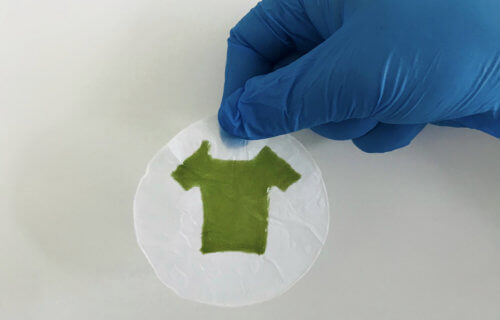
ROCHESTER, N.Y. — Algae isn’t the most pleasant of substances to see when out for a dip at your local lake or pond. As it turns out however, the bright green ooze-like plant may be hanging in your closet one day in the future. That’s because scientists have used 3D printing technology to create clothing made from algae.
The plant-like fabric has a wide range of applications ranging from biodegradable clothes to artificial leaves capable of producing oxygen for space colonies, according to a new study. So called “living materials,” which mimic those found in nature, have become increasingly popular in recent years as they are especially strong.
Now scientists have created a hybrid material by combining living and non-living compounds, which can photosynthesize like plants, but is also robust. The 3D-printed cloth is eco-friendly and could help industries reduce the amount of toxic chemicals they use and their carbon emissions, the researchers say.
“Three-dimensional printing is a powerful technology for fabrication of living functional materials that have a huge potential in a wide range of environmental and human-based applications,” says study first author Dr. Srikkanth Balasubramanian, of Delft University in the Netherlands, in a statement. “We provide the first example of an engineered photosynthetic material that is physically robust enough to be deployed in real-life applications.”
How algae can be turned into a strong, wearable fabric
The researchers started with an organic compound, which is produced and excreted by bacteria, known as cellulose. Cellulose has many unique properties, including its flexibility, toughness, strength and ability to retain its shape, even when twisted or crushed. The researchers then used a 3D printer to deposit living algae onto the cellulose, just like a regular printer squirts ink onto a page.
Combining the two produced a unique material with the algae’s ability to photosynthesize and the strength of the cellulose. This meant it could use sunlight to “feed” itself over periods of many weeks and be regenerated by regrowing a small sample. Its unique abilities make it a strong candidate for a variometer of applications, the researchers say. These include artificial leaves, which like the real deal, can convert water and carbon dioxide into oxygen and energy.
The leaves store the energy in the form of sugar, which can in turn be converted into fuel. This could one day help grow plants in hostile places such as outer space colonies.
While most artificial leaves produce toxic chemicals, the researchers only used eco-friendly materials.
“For artificial leaves, our materials are like taking the best parts of plants – the leaves, which can create sustainable energy, without needing to use resources to produce parts of plants like the stems and the roots that need resources, but don’t produce energy,” explains co-author Dr. Anne Meyer, of the University of Rochester. “We are making a material that is only focused on the sustainable production of energy.”
Innovative 3D-printed ‘living material’ offers an eco-friendly world of potential
The material could also be used to produce photosynthetic skin grafts, which help wounds heal. “The oxygen generated would help to kick-start healing of the damaged area, or it might be able to carry out light-activated wound healing,” adds Meyer.
It could also help the fashion industry address some of the negative environmental effects associated with synthetic textiles and plastics. Garment made from algae would be sustainably produced, 100 percent biodegradable and not need to be washed as often, reducing water consumption.
“Our living materials are promising because they can survive for several days with no water or nutrients access, and the material itself can be used as a seed to grow new living materials,” adds co-author Dr Marie-Eve Aubin-Tam, also of Delft University. “This opens the door to applications in remote areas, even in space, where the material can be seeded on site.”
The findings were published in the journal Advanced Functional Materials.
SWNS writer Tom Campbell contributed to this report.
